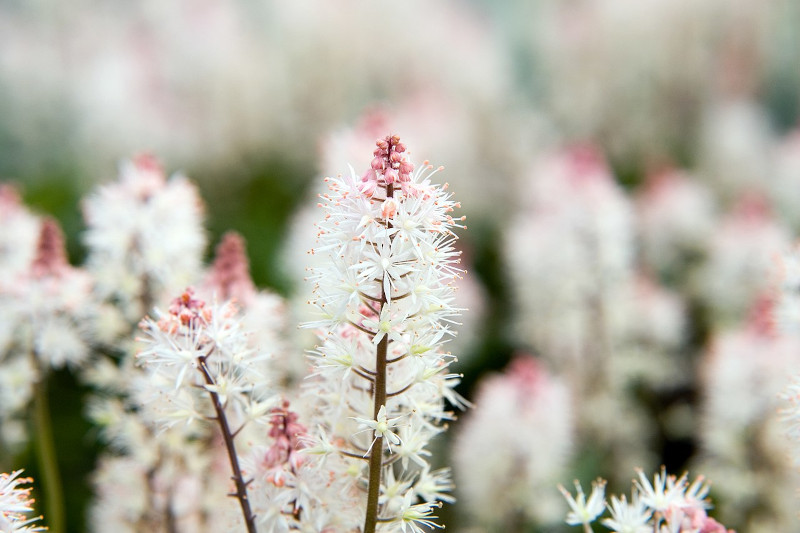
Heartleaf Foamflower Facts
- The most often employed common name for this delicate product of botanical evolution is the almost poetic term of Heartleaf Foamflower. It does have a few other titles, though. These include coolwort, false miterwort, and Allegheny foamflower.
- Inside of many scientific circles, however, the plant’s perhaps better known by its technical moniker. Fortunately, that’s a comparatively simple tag for the layperson to pronounce. That’s because it holds the official designation of the Tiarella cordifolia.
- The lovely small Angiosperm received that appellation due to the efforts of Carl Linnaeus. The highly esteemed Swedish zoologist recorded the first acknowledgement of it as a separate and distinct species. He managed that noteworthy feat in 1753.
- Thankfully, the remarkable Heartleaf Foamflower appears to be maintaining a population base that’s both stable and sufficient. That pleasant state also seems to hold true across its entire range. The IUCN thus does not currently show it on its Red List.
- The flora nevertheless still faces several potential threats to its continued existence as a species. Like all other forms of life on earth today, most of these stem from the actions of man. They include the related dangers of habitat loss and climate change.
Related Articles
Heartleaf Foamflower Physical Description
In the lovely Heartleaf Foamflower, nature created a charming herbaceous perennial plant that captivates those who encounter it. Yet, it does so purely do to its visual appeal. That’s true since, compared to many similar flora, it’s a relatively small example of its kind.
Each specimen of the marvel of botanical evolution produces multiple thin, highly erect stalks. These features of the species also tend to manifest a somewhat fuzzy covering. In height, these vary significantly, usually ranging from 6 – 16 in (15 – 40 cm).
The appealing leaves themselves, though, develop separately. These appear at the ends of even thinner stems, also with a fuzzy texture. Protruding from the stalk, these stems occasionally grow to lengths equaling 8 in (20 cm). In color, they appear a light green.
Yet, the leaves themselves also merit notice. They possess an overall heart-shaped appearance, forming the basis of the common name of the plant. Each forms a sharp tip, along with 5 -7 lobes. These appear opposite each other along the spine, plus one at the tip.
It’s the delicate blooms of the Heartleaf Foamflower that usually receive the most attention, however. The plant produces these at the tip of the vertical stalk. Its lovely flowers additionally develop in large clusters, generally numbering anywhere from 15 – 50 blooms.
Individually, each of the blossoms remain quite small, with a feathery texture. Showing white in color, the collective combination gives the grouping a fuzzy appearance. Despite their small size, though, each beautiful flower has 10 stamens, 5 petals, and 5 sepals.
- Kingdom: Plantae
- Phylum: Tracheophyta
- Class: Eudicots
- Order: Saxifragales
- Family: Saxifragaceae
- Genus: Tiarella
- Species: T. cordifolia
Heartleaf Foamflower Distribution, Habitat, and Ecology
Pleasantly, the gorgeous Heartleaf Foamflower evolved as native to a relatively broad swathe of the earth’s surface. The full extent of that zone of habitation comes as no surprise to many who learn of it, however. That’s because it’s native to North America.
Within the confines of that continent, though, it inhabits parts of both Canada and the United States. But, the plant only lives natively in the approximate eastern portions of both countries. Inside of those specific boundaries, however, the species is actually far-ranging.
In Canada, it lives in most of the southeast sections, extending that as far as Nova Scotia. In the United States, that habitat zone reaches as far west as northestern Wisconsin. From there, it stretches south through the Appalachian Mountains to Mississippi and Alabama.
The remarkable creation of Nature displays moderate flexibility regarding its habitat preferences. The flora frequently develops naturally in a surprising range of different, if similar, ecosystems. All of these do share certain basic conditions it requires, though.
It proliferates best in regions of either full or partial shade. It also needs well-drained or at least reasonably well-drained soil. In its native range, it most frequently develops naturally in primarily deciduous forests. Yet, it may appear in places such as parks, too.
The stunning Heartleaf Foamflower typically blooms between the months of March and July in most parts of its range. Surprisingly, detailed data concerning its pollinators does not yet exist. However, it’s believed these include various locally common butterflies and bees.
Species Sharing Its Range
Check out our other articles on 7 Magnificent West Coast Marvels, Amazonian Manatee, Mount Jade, Southern Darwin’s Frog, Cairns Birdwing, Spiny Butterfly Ray, Great Potoo, Philippine Cobra
